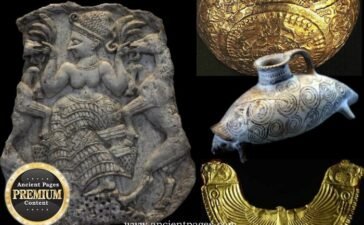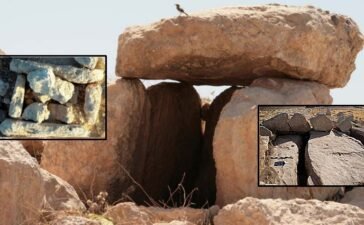Jan Bartek – AncientPages.com – The Danish island of Bornholm offers a fascinating journey through time, with its history of human settlement stretching back to 9000–8000 B.C.
Early island settlers accessed the regions now known as Poland and Germany via a land bridge. However, over time, this land connection disappeared, leaving Bornholm as an isolated island. As a result, its inhabitants had to adapt to the changing conditions brought about by their newfound isolation.
Credit: Andreas Faessler – CC BY-SA 3.0, Wolfmann – CC BY-SA 4.0, R. Fortuna; x-ray by A. Jouttijärvi; drawing by A. Kuzioła, Image compilation AncientPages.com
One can still witness the legacy of these early communities in sites like the fortified camp near Aakirkeby, dating back to around 3500 B.C. The preserved earthworks and fortifications tell stories of defense, agriculture, and resource management. There is no doubt this was once a thriving society.
Moreover, the ritual rock carvings at Madsebakke and the standing stones from centuries past speak volumes about the inhabitants’ spirituality and artistic expression.
One can say that Bornholm’s unique identity was forged at the crossroads of Germanic, Scandinavian, and Slavic influences.
During pivotal eras such as the Viking Age and Middle Ages, Bornholm stood as a strategic stronghold in the Baltic Sea. Recent studies suggest that this local community may have played a crucial role in facilitating transregional connections during the Iron Age, a testament to its significant impact on shaping history across borders.
Was Bornholm An Ancient International Trading Hub?
During the Iron Age, Bornholm may have played a significant role as a hub for trade and commerce. This island potentially served as a crucial point for the exchange of goods and cultural interactions between continental Europe—specifically the areas that are now Poland and northern Germany—and Jutland and southern Scandinavia. However, the extent of these interactions, their variability, importance to local communities, and their influence on other regions around the Baltic Sea remain somewhat unclear.
Grave furnishings and reconstruction of supposed costumes. A) grave 93: iron brooches, belt hook; B) grave 158: iron knife, copper-alloy brooch, glass and gold beads (drawing by A. Kuzioła; photograph by R. Fortuna).
To address these uncertainties, an international research project titled ‘Bornholm – the island in the middle’ is underway. This collaborative effort involves researchers from Denmark, Sweden, Poland, and Norway who aim to illuminate social and economic transformations within local communities as well as international contacts in the Baltic Sea region during the early Iron Age. The project focuses on materials from Store Frigård cemetery.
Researchers have examined artifacts from Store Frigård cemetery on Bornholm, including items such as women’s Scandinavian belts and spearheads that were prevalent in this region. Excavations at this site took place between 1954 and 1963, and the discovered artifacts are now housed at the National Museum in Copenhagen. Store Frigård stands out as one of the few sites on Bornholm and indeed across the entire Baltic Sea region, which vividly demonstrates transregional connections and population movements during that era.
What Kind of Artifacts Were Found At Store Frigård?
At the archaeological site of Store Frigård, over 1,200 cremation graves and one skeletal grave have been discovered, dating from the early Iron Age to the late Roman period (500 B.C. – 400 C.E.). This discovery establishes Store Frigård as the most extensive and longest-functioning cemetery not only on Bornholm but throughout the entire Baltic region.
Finds from grave 94 and a possible belt reconstruction (8). With the exception of the glass bead (3), all the artefacts are made of iron (photograph by R. Fortuna; x-ray by A. Jouttijärvi; drawing by A. Kuzioła).
Among these graves, at least 650 metal artifacts were uncovered, including ornaments, clothing parts, tools, and weapons, approximately 95 percent of which are made of iron. Pottery artifacts were discovered in about 533 graves, with the quantity of vessels differing among them. Notably, some of these vessels bear a resemblance to pottery styles from neighboring regions around the southern Baltic Sea area.
The inhabitants of Bornholm during this period demonstrated interregional connections through items like ‘Scandinavian belts,’ which featured decorative multi-part iron fittings popular in both the Baltic zone and southern Scandinavia.
According to Professor Piotr Łuczkiewicz from Maria Curie-Skłodowska University’s Institute of Archaeology, grave inventories and anthropological analyses suggest these fittings were part of women’s attire. While typological analysis indicates that these sets likely originated from Gotland or mainland Sweden, there is also a possibility that they were locally produced on Bornholm based on imported designs.
Numerous brooches discovered in the cemetery are interpreted as evidence of advanced intercultural interactions. The local patterns from the last centuries B.C. align precisely with other findings from central Poland and northern Germany. Regarding weaponry, similar types of spearheads, shields, and swords were found on Bornholm, Öland, Gotland, and in southern Scandinavia.
Iron shield boss from grave 869 (1) and iron sword from grave 909 (2) (drawing by A. Kuzioła; photograph by R. Fortuna).
Professor Luczkiewicz explains that the presence of foreign clothing elements suggests the dissemination of cultural patterns and interregional trade. It may also indicate population mobility, including the movement of craftsmen and exogamy—marriages outside local groups. He notes that similarities in weaponry might reflect extensive military alliance networks. The professor emphasizes that understanding such large-scale contacts requires combining archaeological methods with modern natural science techniques.
All cemetery finds will undergo further analysis. Scientists plan metallographic research to investigate the origin and technology behind the iron objects found in abundance at the Bornholm site. They aim to determine whether the island was self-sufficient in raw materials, craftsmen’s expertise, and technological knowledge, or reliant on imports from places like Sweden.
Additionally, osteological and statistical analyses will provide insight into social differentiation within the local community. Palaeogeographic studies are planned to reconstruct historical landscapes alongside isotope analyses of bone samples from graves containing both local and potentially foreign items. This will help determine the percentage of those buried at Store Frigård who might have been immigrants.
See also: More Archaeology News
“The variety of artefacts at Store Frigård and the interdisciplinary approach of the project provide an insight into almost a millennium of the history of Bornholm and the Baltic Sea area, its dynamics and the changing relationships and alliances between Iron Age societies.
Open to extending the existing research network and to further research ideas, the project also contributes to the understanding of local networks on Bornholm, and future publications will fill a gap in our knowledge of Iron Age Bornholm,” the researchers conclude in their study.
The study was published in the journal Antiquity.
Written by – Jan Bartek – AncientPages.com Staff Writer










